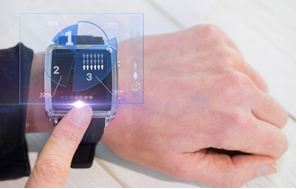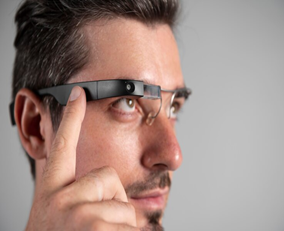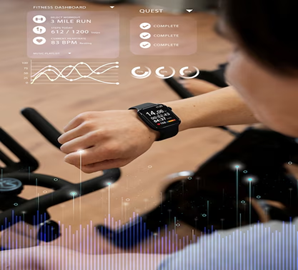AI in Wearables: New Way to Interact with the World
The consumer market for wearable devices is increasing steadily. Wearables are small electronic and mobile devices or computers with wireless communication capabilities incorporated into gadgets, accessories, or clothes, which can be worn on the human body. There are also invasive versions of the wearables such as micro-chips or smart tattoos. Some of the most common wearable devices include smart glasses and smart watches. Apart from these variable devices can also include headsets, jewelry, garments, armbands, chest straps, shoes, helmets, lenses, patches, and hearing aids. Wearables are used to collect, transmit, and analyze the data commonly collected from the body of a human or animal. They are commonly built using sensors, actuators, and computation parts.
Applications of AI-Powered Wearables
Extensive use of AI-powered wearables is evident in the medical domain. It is revolutionizing the healthcare system by providing cost-effective healthcare services and transforming the way we approach health in our day-to-day lives. These devices can be used for early diagnosis and management of medical conditions by measuring vital signs revealed by the human body such as body and skin temperature, blood pressure, and heart rate.

The wearable determines the health conditions using embedded sensors. These sensors have various applications including the determination of skin temperature and oxygen saturation level in the blood, capturing of blood volume, pulse, electrical activity of the brain and the health of muscles and nerve cells, recognition of body movement and activities, recording the electrical activity of the stomach, and estimating heart rate and breathing rate to list a few. These can be extremely useful in taking care of the elderly and children as they are capable of fall detection, stress detection, arrhythmia detection, rehabilitation, hydration monitoring, and sleep monitoring.
A paradigm shift is on the horizon where AI-powered wearable devices are used for the amplification of human intelligence. These devices will offer less intrusive, more intuitive ways to amplify our intelligence. For instance, Apple AirPods connect to Apple devices and integrate with Siri via voice commands. Apple has also earbuds equipped with biometric sensors that can record data such as a user's temperature, heart rate, and movement. Similarly, Google's Pixel Buds give users direct access to Google Assistant and its powerful knowledge graph.
The AI-powered wearable devices, not only assist in human intelligence application but also contribute considerably to business intelligence. In the industrial domain, wearable devices can make workstations more ergonomic. The workers can be equipped with appropriate wearable devices to accelerate the industrial processes leading to shortened working hours and better psychological health.
Alter Ego is the use case of work process optimization in an industrial setup. It uses silent speech recognition or internal articulation, to measure the electrical signals the brain sends to the internal speech organs. It is a non-invasive device that is worn over the ear and along the jawline. It measures the signals from the voluntary nervous system, meaning users must intentionally think of speaking words to trigger the device. It translates these signals into commands to control other systems, such as IoT devices, and query information from a Google search. A user controls the device without opening their mouth and without any externally observable movements. They simply must think about the words they would have asked Siri or a smart speaker out loud. Information is then relayed back to the user through audio. AlterEgo uses bone-conduction audio to respond to users, which completes the discreet information loop silently. The entire interaction is completely internal to the user, almost like speaking to oneself.

Augmented reality devices represent another interesting foray into modern intelligence amplification. Google Glass, smart eyewear that failed in the consumer market, is being used in enterprise and industrial applications. Employers such as GE are implementing smart eyewear technology to increase the efficiency of their warehouse and manufacturing workers. Technicians at GE use guided instructions overlayed in their field of view to streamline the work processes while servicing or repairing manufacturing equipment.
Yet another application of AI-powered wearables is in the optimization of athletic performance. They are used for the identification of patterns in athletic performance. These can be used to tap changes in acceleration magnitude, jerk of motion, and seizure detection. Continuous real-time data before, during, and after training as well as during the event can be analyzed to modify and improve athletic performance. The sensors used in these devices can effectively monitor force, displacement, velocity, and duration variables during resistance training sessions. The wearable platform also provides real-time corrective feedback based on multidimensional physiological data collected from a body sensor network. Thus, these sensors act as wearable coaches that direct the athlete’s movements
AI-powered wearables can also contribute to environmental protection. For instance, it is impossible to tackle air pollution without first measuring and mapping its spread and intensity. However, air quality monitoring stations and sensors can be expensive and difficult to scale. Wearable sensors democratize the collection of air quality data, making it possible for ordinary citizens to understand their exposure to air pollution and use this data to campaign for environmental justice.
Challenges to AI in the Wearables Industry
Machine learning approaches utilized by AI-powered devices require the availability of enough data for training to generalize well for unseen events. Not only this, the data must be reliable especially in the healthcare sector as any misjudgment could lead to a potential loss of life. Data reliability can be ensured by conducting a wide range of experiments while reporting the results transparently. It is also critical for evaluating different techniques and finding promising research directions.
Further, for reliably calculating the accuracy of machine learning models, the use of cross-validation techniques should be applied. It is done by testing the model on unseen data that have not been used in training. The two types of cross-validations are record-wise or subject-wise. Additionally, many criteria affect the decision of model selection when it comes to wearable devices. These include maximization of evaluation metrics, interpretability or explainability, and size to list a few. This can considerably affect the computational complexity for inference and for online training on the device for personalization adding to the concerns of wearable device technology as it offers limited computation power.
There are three deployment alternatives for the machine learning model for the wearable device i.e. either to deploy the model on the wearable device, an edge device, or on the cloud. The main disadvantages of on-device computing include the limited device computing power, storage, and battery life. This can be tackled by offloading computations to be done on one or more edge devices. However, edge computing can reduce data transmission to the cloud and consequently reduce power consumption and improve privacy by analyzing sensitive private data on a local gateway, filtering it, and compressing it, instead of doing it on a cloud away from the user's control. Cloud computing comes as a trade-off for higher costs, power consumption, latency, and challenges for preserving the privacy of both the data and the machine learning model.
Power consumption is the main limitation of wearable devices due to their limited battery lifetime in general. For machine learning applications on wearable devices, power consumption is greatly affected by the need to send physiological data measured by the device's sensors to the cloud to perform computations on the cloud. Researchers proposed a hybrid approach of using less battery, low sampling rate, and wearable RFID tags to mitigate this challenge. These can be powered intermittently by a reader with additional passive RF tags that capture the presence and use of specific objects for daily activity recognition. Another way to reduce power consumption is to reduce the data stored and transmitted to the cloud.

Another major concern with wearable devices is that they have limited storage due to small device size and weight requirements. This can be talked about by accurate data selection, data dimensionality reduction, and designing new models with acceptable prediction accuracy while minimizing model size and prediction costs. There is also an inherent bias towards collecting data from only those who can afford these sensors, which creates a socio-economic bias in the models. Other challenges such as missing data, outliers, signal noise, and artifacts can introduce large variations and produce erroneous algorithms.
The security of wearable devices is a big challenge. They may be able to collect the data locally or send them to an external device. In both cases, the data should be encrypted to enforce their privacy. Consumers are rightfully wary of handing over their data to big businesses which may use it to manipulate consumers or sell it to other businesses with that intention. As more personal data is captured with these devices, and as AI can extrapolate more details about consumers, everyone is more vulnerable. Businesses should focus on building trust with consumers by being transparent with their data practices and prioritizing privacy and autonomy when developing and implementing more personalized, intelligence-amplifying technologies.
Hearables, along with other voice-enabled devices, allow users to seek information and complete tasks without a screen interface, but they are inherently less discreet than smartphones. Users must speak their questions and commands aloud, which may not be desirable or possible in certain situations. This lack of discretion diminishes the impact of the voice-enabled intelligence amplifying interfaces as it limits the contexts in which they can be used. This signifies the need for an intelligence-amplifying device that is less obtrusive than a smartphone and more discreet than a voice interface.
In a nutshell, AI is a promising avenue for integration into wearable technology. While the use of AI brings with it a separate set of challenges, it also has numerous advantages in its ability to translate the use of wearable technology on a large scale. There is an immense opportunity for medical practitioners, patient caretakers, business leaders, athletes, and common people in general to capitalize on these intelligence-amplifying devices. Additionally, each new device further reduces the barriers between individuals and knowledge to provide individuals with new ways to interact with the world.